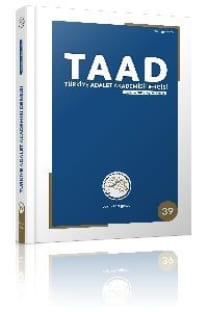İnsan haklarının gelişiminde uluslararası kamu örgütlerinin rolü: etkinlik ve eksiklik denklemi
The role of public international organanizations in the promotion of human rights: the balance of efficiency and shortcoming
___
- ALVEREZ, Jose E., ‘International Organisations. Then and Now’, (April 2006) The American Journal of International Law, Vol.100, No.2 , 324-347, s. 333.
- AMERASINGHE, C. F., ‘ The Law of International Organisations. A Subject Which Needs Exploration and Analysis’,(2004) International Organisations Law Review 1, 9-21.
- AGİT Resmi İnternet Sahifesi, ‘Office for Democracy and Human Rights’, _____http://www.osce.org/odihr/>.
- Birleşmiş Milletler Resmi İnternet Sitesi, http://www.un.org/en/members/.
- BLOKKER, Niels, ‘International Organisations and Their Members. International Organisations Belong to All Members and To None’, (2004) International Organisations Law Review 1, 139-161.
- BORGEN, Christopher J., ‘International Tribunals and the Transmission of Norms. The Hegemony of Process’, (2007) 39 George Washington International Law Reivew, 685-764.
- BOYLE, Alan ve CHINKIN, Christine, The Making of International Law (Oxford University Press, Oxford 2007).
- BROWN, Chris, ‘Universal Human Rights. A Critique’, in Tim Dunne and Nicholas J. Wheeler (eds.), Human Rights in Global Politics (Cambridge University Press, Cambridge-1999), 103-127.
- ERGÜL, Ergin, Avrupa İnsan Hakları Mahkemesi ve Uygulaması (İkinci Baskı, Yargı Yayınevi, Ankara 2004).
- GREER, Steven, The European Convention on Human Rights: Achievements, Problems and Prospects (Cambridge University Press, Cambridge 2006).
- HURREL, Andrew, ‘Power, Principles and Prudence. Human Rights in a Divided World’, Tim Dunne and Nicholas J. Wheeler (eds.) içinde, Human Rights in Glo-bal Politics (Cambridge University Press, Cambridge-1999 ), 277-302.
- KARNS Margaret P., and MINGST, Karen A., International Organisations. The Politics and Processes of Global Governance ( Lynne Rıenner Publishers, London 2004).
- KLABBERS, Jan, ‘Constitutionalism Lite’, (2004) International Organisations Law Review 1, 31-58.
- KLABBERS, Jan, ‘Two Concepts of International Organisation’, (2005) International Organisations Law Review 2, 277-293.
- LEATHLEY, Christian, ‘An Institutional Hierachy to Combat the Fragmentation of International Law. Has the ILC Missed and Opportunity?’, 40 New York University Journal of International Law and Politics, 259-306.
- PAZARCI, Hüseyin, Uluslararası Hukuk ( Sekizinci Baskı, Turhan Kitabevi, An-kara 2009).
- PENTİKAINEN, Merja and SCHEININ, Martin, ‘A Comparative Study of the Monitoring Mechanisms and the Important Institutional Frameworks For Human Rights Protection within the Council of Europe, the CSCE and the European Community’, A. Bloed, L. Leicht, M. Nowak, A. Rosas (eds.) içinde, Monitoring Human Rights in Europe. Comparing International Procedures and Mechanisms (Martinus Nijoff Publishers, Netherlands 1993), 93-119, s. 106.
- REINISCH, August, ‘Editorial. How Necessary is Necessity For International Organisations’, (2006) International Organisations Law Review 3, 177-183.
- SHAW, Malcolm N., International Law (Sixth Edition, Cambridge University Press, Cambridge 2008).
- SHERMERS, Henry G., ‘The Birth and Development of International Institutional Law’, (2004) International Organisations Law Review 1, 5-8.
- SMITH, Rhona K.M., Textbook on International Human Rights (Third Edition, Oxford University Press, Oxford 2007).
- TEZCAN, Durmuş, ERDEM, Mustafa R., SANCAKDAR, Oğuz, Avrupa İnsan Hakları Sözleşmesi Işığında Türkiye’nin İnsan Hakları Sorunu (İkinci Baskı, Seçkin Yayıncılık, Ankara 2004).
- TOYNBEE, Polly, Limp Liberals Fail to Protect Their Most Profound Values, The Guardian, October 10, 2001, http://www.guardian.co.uk/Archive/Article/0,4273, 4274017, 00.html> 2.2.2009 tarihinde ziyaret edilmiştir.
- Uluslararası Adalet Divanı Resmi İnternet Sahifesi, http://www.icj-cij.org/documents/index.php?p1=4&p2=2&p3=0.
- ISSN: 1309-6826
- Başlangıç: 2010
- Yayıncı: Türkiye Adalet Akademisi
Hükmün açıklanmasının geri bırakılması ve memuriyete etkisi
Nusret İlker ÇOLAK, Dursun ÖZDEMİR
Kazara oluşturulmuş fulajdan yola çıkarak yazı yaşı tespit etme-olgu sunumu
Lokman BAŞER, Ramazan TURAN, Gürol BERBER, Muhammed Nabi KANTARCI, Eyüp KANDEMİR
Düşünce ve ifade özgürlüğü kapsamında Türk ceza kanunu'nun 301. maddesinin değişimi
Karşılıksız çek suçunda etkin pişmanlık
İdare hukuku açısından hasta hakları uygulamaları
Egemenlik ve siyasal iktidar perspektifinde anayasacılık ve anayasa
İnsan haklarının gelişiminde uluslararası kamu örgütlerinin rolü: etkinlik ve eksiklik denklemi
La haye uluslararası ceza mahkemesine giden süreçte uluslararası ceza yargılaması
Yeni Türk ticaret kanunu ışığında acentelik sözleşmeleri
Hakimler ve savcılar yüksek kurulu'nun yapısının değerlendirilmesi
